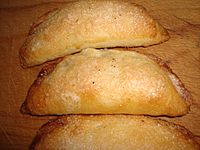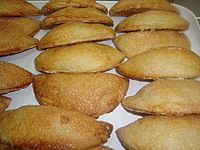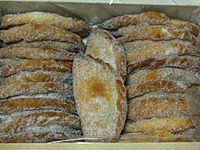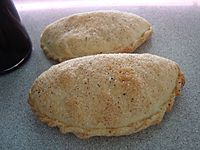Pastisset facts for kids
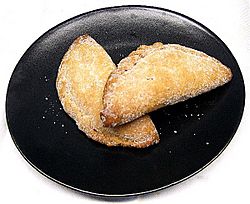 |
|
| Alternative names | Casquetes, pastissets (Catalonia), flaons, moniatos (Valencian Community), tortas de alma (Aragón) |
|---|---|
| Type | Pastry |
| Place of origin | Spain |
| Region or state | East Spain (Aragón, Catalonia, Valencian Community) |
| Main ingredients | Olive oil, flour, eggs, Catalan moscatell, anissette |
Pastissets are delicious stuffed pastries from eastern Spain. You might also hear them called casquetes, pastelicos, dulces de alma, or flaons. These tasty treats are popular in areas like Catalonia, the Valencian Community, and Aragón.
Pastissets are usually fried and filled with sweet jams or other yummy ingredients. Common fillings include sweet potato jam, almond paste, or a special jam called cabell d'àngel (angel's hair). Sometimes, they are even filled with fresh mató cheese or codonyat (quince paste). They are especially famous in the Terres de l'Ebre region and the Valencian Community. In Mallorca, there's a very similar pastry known as a rubiol.
Making Pastissets
Making pastissets is a fun process! In places like Amposta, the dough is made from a simple mix of olive oil, flour, and eggs. They also add a special sweet wine called Catalan moscatell and a hint of anissette (a sweet anise-flavored liqueur).
Once the dough is ready, it's rolled out and cut into circles. Then, a spoonful of the sweet filling is placed in the center of each circle. The dough is folded in half, creating a crescent shape. The edges are gently pressed together, often with a fork, to seal the pastry and give it a pretty pattern. After they are cooked, usually by frying, they are often sprinkled with sugar to make them even sweeter.
Gallery
See also
 In Spanish: Pastisset para niños
In Spanish: Pastisset para niños


